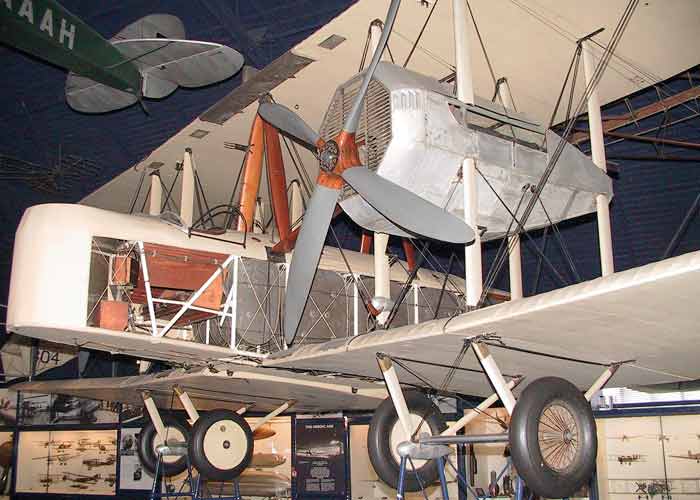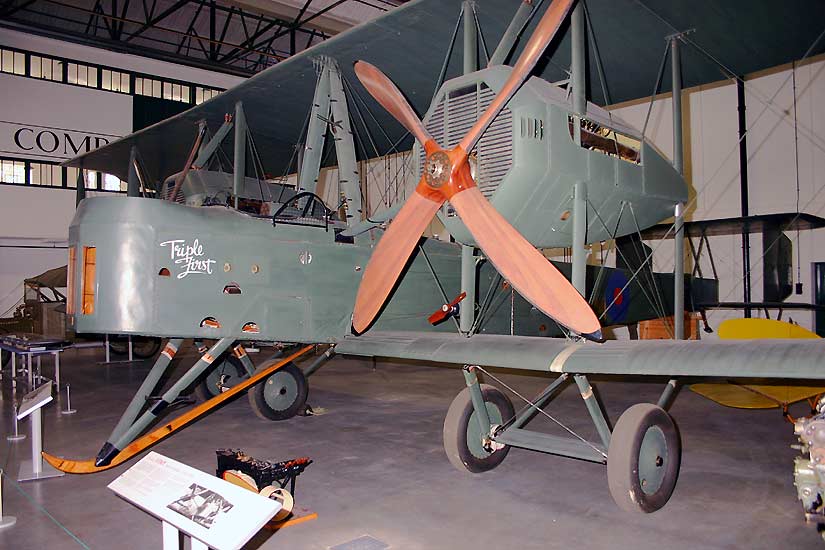

Vickers Vimy Mk IV/F.B.27A (G-EEAR) [@ Science Museum]
 In the closing stages of WW1 Vickers produced a large
biplane bomber, the F.B.27 Vimy, with the object of attacking Berlin. Ordered
into large-scale production for the newly-formed Independent Force, (the RAF’s
strategic bombing force), the Vimy showed exceptional handling qualities and
proved capable of lifting a greater load than the Handley Page 0/400 on half the
power.
Although designed in 1917, production of the Vimy only got under way after the end of WW1 with
deliveries to RAF bomber squadrons beginning in July 1919
when it began to re-equip units in the Middle East. During those early years the
RAF used some of these aircraft to fly mail services between Cairo and Baghdad.
In the closing stages of WW1 Vickers produced a large
biplane bomber, the F.B.27 Vimy, with the object of attacking Berlin. Ordered
into large-scale production for the newly-formed Independent Force, (the RAF’s
strategic bombing force), the Vimy showed exceptional handling qualities and
proved capable of lifting a greater load than the Handley Page 0/400 on half the
power.
Although designed in 1917, production of the Vimy only got under way after the end of WW1 with
deliveries to RAF bomber squadrons beginning in July 1919
when it began to re-equip units in the Middle East. During those early years the
RAF used some of these aircraft to fly mail services between Cairo and Baghdad.
In total four prototypes were built. The first Vimy F.B.27 prototype, numbered B.9952, was powered by two 200 hp Hispano-Suiza engines, later fitted with two 260 hp Salmson water-cooled radial engines, flew for the first time on 30th November 1917 at Joyce Green, Kent. The Salmson engine version of the design was not developed further. Two 260 hp Sunbeam Maori engines powered the second Vimy FB.27 prototype, numbered B.9953. This plane was not tested extensively because it crashed on an early flight. This is listed as the Mk I. Two 260 hp Fiat A-12 engines powered the third Vimy FB.27 prototype, numbered B.9954. The Fiat version of the F.B.27 was proved to be good and ordered in quantities. This is listed as the Mk II.
There was a Mk III version listed in the Technical Department Instruction No. 538A, dated January 1919, powered by two 230 hp B.H.P. engines but it is doubtful if any airplanes were completed with those engines. The Americans were interested in the Vimy and asked if they could have Liberty engines installed. A trial installation was made but it was destroyed by fire at Joyce Green. The first production model was the Fiat powered machine but then in the summer of 1918 the Vimy appeared in its best-known form with two 360hp Rolls-Royce Eagle VIIIs V12 of which the great majority of production machines had these engines. This is listed as the Mk IV (F.B.27A Vimy II) and the first Vimy to have the Eagle engines was production number F.9569. The performance of the Vimy IV was excellent and had a top speed of 98 mph at 5,000 feet. Unfortunately the type was too late to see operational service in WW1 despite over 1,000 Vimy's being ordered. Vickers built a total of 147 at Bexleyheath, Crayford and at Brooklands, in addition to approximately a further 100 by other manufacturers.
The photograph (right) shows the Rolls Royce Eagle engine. It was developed during the WW1 and started the line of 12-cylinder engines that culminated in the famous Merlin. The Eagle powered many notable aircraft during the war. This particular engine was one of the actual engines that powered FB27 on its historical first transatlantic flight.

Vickers Vimy Mk IV/F.B.27A (G-EEAR) [@ Science Museum]
This is the actual modified Vimy Mk IV aircraft in which Captain John Alcock (pilot) and Arthur Whitten Brown (navigator) made the first non-stop flight across the Atlantic. They took off from Lester's Field, near St. Johns, Newfoundland on 14th June 1919. The Vimy landed 15th June 1919 at Clifden in Ireland. The time for the crossing was sixteen hours and twenty seven minutes. The two men were received as heroes in London. For their accomplishment Winston Churchill, who was then Britain’s Secretary of State, presented them with Lord Northcliffe’s Daily Mail prize of £10,000. A few days later King George V knighted both men at Buckingham Palace for recognition of their pioneering achievement. The aircraft was rebuilt by Vickers at Brooklands and presented to the Museum by the Vickers and Rolls-Royce companies in December 1919.

Vickers Vimy Mk IV/F.B.27A (F8614/G-AWAU) [@ RAF Hendon]
The type began to be withdrawn from the bomber role in 1924, but many served on with various training establishments and parachute schools, the last military Vimy being retired from 4 Flying Training School at Abu Sueir, Egypt, in 1933. Many variants of the basic Vimy were produced, both military and civil; the last two were the Vimy Ambulance of which 5 were built and the Vernon bomber/transport of which Vickers built 55. The Vernon was a development of the passenger variant of the Vimy bomber and was powered by twin Napier Lion engines or Rolls-Royce Eagle VIII engines. The variant entered service in 1921 and became the first dedicated troop transport of the RAF. In February 1923 the Vernons of RAF 45 and 70 Squadrons airlifted nearly 500 troops to Kirkuk, Iraq, after the civilian area of the town had been overrun by Kurdish forces, and so became the first-ever strategic airlift of troops. The Vernon remained in RAF service until replaced by the Vickers Victoria from 1927. The Vimy is best remembered for its long-range pioneering flights, including the crossing of the Atlantic by Alcock and Brown in 1919.
F8614 is a reproduction and bears the name "Triple First" in recognition of the first ever non-stop transatlantic flight in 1919 and two other record-breaking flights to Australia and Cape Town. In May 1967 the Vintage Aircraft and Flying Association decided to build a Vimy replica to commemorate the 50th anniversary of the Alcock and Brown's trans-Atlantic flight. When told of the project Rolls Royce began a world wide search for engines. Eventually they were successful and recovered three original former Dutch Air Force Rolls Royce Eagle Mk.IX engines in Holland. One had been driving a canal barge and the other was standby power in a windmill. The engines were reconditioned by Rolls Royce apprentices at Hucknall, Derby. Although three original Vimy propellers were located, new propellers were in the event constructed. The aircraft was completed on Friday the 30th May 1969 and its maiden flight was on the 3rd June. The aircraft went through an intensive flight test programme before receiving a Special Category Certificate of Airworthiness on the 5th June. The next day the aircraft crossed the Channel to appear at the Paris Air Show. On 9th June it returned to the United Kingdom and two days later, after being repainted in service markings, flew to Ringway Airport, Manchester to become the centre of an Alcock and Brown exhibition. The exhibition lasted a month and on the 14th July it was being prepared to fly to the Rolls Royce test airfield at Hucknall when it caught fire. The fire, which is thought to have been caused by concentrated sunlight reflecting off a polished engine cowling onto the doped fabric of the wing, resulted in extensive damage. However, it was rebuilt as a static exhibit to represent this important aircraft.


Vickers Vimy Mk IV/F.B.27A (F8630/G-EAOU) [@ Adelaide Airport Museum]
Powered by two 360 HP Rolls Royce Eagle VIII engines, this former RAF Vickers
F.B.27A Vimy IV bomber (F8630) was delivered too late to see service during WW1.
However, piloted by Captain Ross Smith (Australian Flying Corps) with his
brother Lieutenant Keith Smith (Royal Air Force) flying as the co-pilot and
navigator in the 1919 England to Australia Air Race. Nicknamed
God 'elp All Of Us, F8630 became one of the more significant
aircraft in Australian aviation history since F8630 became the first aircraft
ever to fly from England to Australia. For the race F8630 was stripped of
unnecessary items, including the radio, and replaced with extra fuel tanks and
spare parts. The flight started in poor weather from Hounslow, England, on
12th November 1919 and arrived in Darwin, Australia, 27 days and 20
hours later, on 10th December 1919 after flying the 18,000 km journey
at an average of 137 kilometres per hour. The brothers were knighted by
King George V on 22nd December 1919 for the record breaking flight.
F8630 was donated by Vickers to the Australian government and eventually became
part of the Australian War Memorial collection.
In 1921 the F8630 was entered on to the RAAF Register as A5-1 and so became the
only Vimy to officially serve with the RAAF (but was never used).
In the years that followed F8630 was successively, stored, transferred to the
War Museum, returned to the RAAF, dismantled, re-assembled, partially burnt, and
finally rebuilt.
In 1958 G8630 was placed on permanent display in Adelaide in the
purpose-built building where it remains today.